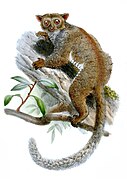The needle-clawed bushbabies are the two species in the genus Euoticus, which is in the family Galagidae. Galagidae is sometimes included as a subfamily within the Lorisidae (or Loridae).
| Euoticus[1] | |
|---|---|

| |
| Northern needle-clawed bushbaby, E. pallidus | |
| Scientific classification | |
| Domain: | Eukaryota |
| Kingdom: | Animalia |
| Phylum: | Chordata |
| Class: | Mammalia |
| Order: | Primates |
| Suborder: | Strepsirrhini |
| Family: | Galagidae |
| Genus: | Euoticus J. E. Gray, 1863 |
| Type species | |
| Otogale pallida J. E. Gray, 1863
| |
| Species | |
Unique to the needle-clawed bushbaby are the keeled nails, featuring prominent central ridges ending in needle-like points, present on all digits except the thumbs, the big toes, and the second foot phalanges which have claws.[2]
The first specimen of E. elegantulus to arrive in Europe from Africa was brought by Gerald Durrell. The uncovering of this bush baby is documented in his 1957 book A Zoo in My Luggage.[3]
The needle-clawed bushbabies have a diet that consists of insects, fruits and gums. Gum tends to be the largest contribute to their diet since 75% of their diet is base around gum.[4]
| Common name | Scientific name and subspecies | Range | Size and ecology | IUCN status and estimated population |
|---|---|---|---|---|
| Northern needle-clawed bushbaby | E. pallidus (Gray, 1863) Two subspecies
|
Western equatorial Africa
|
Size: 18–33 cm (7–13 in) long, plus 28–31 cm (11–12 in) tail[5] Habitat: Forest[6] Diet: Tree gums and resins[6] |
NT
|
| Southern needle-clawed bushbaby | E. elegantulus (Conte, 1857) |
Western equatorial Africa
|
Size: 21–24 cm (8–9 in) long, plus 28–32 cm (11–13 in) tail[7] Habitat: Forest[8] Diet: Tree and liana gums and resins, as well as invertebrates[8] |
LC
|
References
edit- ^ Groves, C. P. (2005). "Genus Euoticus". In Wilson, D. E.; Reeder, D. M (eds.). Mammal Species of the World: A Taxonomic and Geographic Reference (3rd ed.). Johns Hopkins University Press. pp. 123–124. ISBN 978-0-8018-8221-0. OCLC 62265494.
- ^ Ankel-Simons, Friderun (2000). "Hands and Feet". Primate anatomy: an introduction. Academic Press. p. 308. ISBN 0-12-058670-3. (search pages).
- ^ Durrell, Gerald (1957). "The bald-headed birds". A Zoo in My Luggage. Penguin. p. 62. ISBN 0140020845.
- ^ Pozzi, Luca; Disotell, Todd R.; Masters, Judith C. (2014-04-02). "A multilocus phylogeny reveals deep lineages within African galagids (Primates: Galagidae)". BMC Evolutionary Biology. 14 (1): 72. doi:10.1186/1471-2148-14-72. ISSN 1471-2148. PMC 4021292. PMID 24694188.
- ^ Kingdon, ch. Galagos
- ^ a b c Cronin, D. T.; Oates, J. F.; Butynski, T. M. (2021) [errata version of 2020 assessment]. "Euoticus pallidus". IUCN Red List of Threatened Species. 2020: e.T8266A190233329. doi:10.2305/IUCN.UK.2020-2.RLTS.T8266A190233329.en.
- ^ Santilli, Lili (2002). "Euoticus elegantulus". Animal Diversity Web. University of Michigan. Retrieved June 25, 2023.
- ^ a b c Oates, J. F.; Butynski, T. M. (2019). "Euoticus elegantulus". IUCN Red List of Threatened Species. 2019: e.T8265A17961768. doi:10.2305/IUCN.UK.2019-3.RLTS.T8265A17961768.en.
External links
edit

